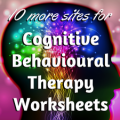
Use CBT to give your clients the emotional resources to better manage those sparks of anger
“Anger is an acid that can do more harm to the vessel in which it is stored than to anything on which it is poured.”
– Mark Twain
I half agree with my namesake. But make no mistake:
Anger can inflict grievous and irreparable damage on other people too!
Legend has it that the distance between opposing political parties (who face one another adversarially) in the British House of Commons is 3.96 meters. Why? Because, back in the day, this was the equivalent of two swords’ lengths.
Back then members of parliament carried swords. But murder was not on the menu. It was thought that having this gap would give enraged MPs time enough to think before murderously acting upon their rage. They might get to finally think before fatally skewering the opposition.
The raging red mist can certainly come upon us with rapier-like swiftness. Which begs a question.
Prefer to watch instead?
What comes first, thought or feeling?
Anger is a trance state.
I recall a client who would become enraged at her boyfriend whenever he seemed to transgress her impossibly tight strictures as to what was right or wrong. Normally shy and demure (amazingly), one day, when in a local shopping mall, she began screaming and yelling at him. After a time, when she ‘awakened’ from this state, she was mortified to suddenly notice a crowd had gathered to watch her tantrum.
She had zoned out everything outside of her rageful focus. A trance state is a narrowed focus in which reality is perceived in very selective ways. Self-consciousness disappears, and, in the case of extreme anger, so do any thoughts of consequence. Other people’s perspectives cannot be appreciated.
We can be clicked into anger before we even have time to think. And because anger, like all strong emotions, works faster than the speed of thought,1 it might seem strange to write about cognitive techniques for anger management.
After all, people often don’t think when the rage comes upon them – and that’s the point. When the emotions hijack the brain, thoughts are often not involved until later.
But cognitive techniques that help people think and stay out of the anger trance can beautifully augment non-cognitive techniques. We just have to make sure we use these techniques alongside each other.
But first let’s look at what anger makes us do.
The motion in the ocean of emotion
We have emotions to get us moving. The motion in emotion. Many emotions compel us away from the source of the feeling. Fear, terror, reluctance and disgust urge you to move away. Other emotions compel us towards the object of our feeling. Lust, greed, addiction and, yes, anger do just that.
When doing therapy, we often find that people who suffer from ‘away from’ emotions such as fears and phobias are more motivated to change than those experiencing ‘towards’ emotional problems such as addiction.
Indeed, anger can be quite seductive for the person who falls under its spell.
A strange seduction
Anger, like lust, is an energizing and focusing feeling. It might save our life as the fight part of the survival mechanism. It might help us right wrongs and stand up for ourselves (as long as we can channel it effectively). Anger has power. And power is compelling.
When we are angry, the world, with all its ambiguities and complexities, is simplified. Daunting doubt is vaporized and replaced by delicious and unequivocal certainty. We are energized and we feel stronger, even indomitable. Certainty, loss of self-consciousness, instant attention and feelings of power can become quite addictive.
Make no mistake – anger can be a real buzz.
But if your client does need motivation to vanquish their anger, or at least bring it to heel, you can remind them of the following.
It’s a deadly seduction
Chronic anger is a danger not just to the victims of rage, but also to the enraged. And the danger extends well beyond the relationships that can be destroyed and the careers that can be ruined.
Modern research into health and mortality has found that releasing extreme anger is just as damaging to the heart and immune function as keeping it in.2 And of course, millions lie dead or traumatized because other people chose to express rather than suppress their anger.
Getting very angry very often is a bigger predictor of early death through heart disease than smoking, bad diet, and lack of exercise put together. Even recalling times you felt very angry can be dangerously bad for the heart.3
Uncontrolled and excessive anger also makes us make mistakes. Sometimes major ones.
Anger makes us dumb
A client of mine, a highly intelligent man, had done some – by his own admission – “incredibly stupid things” while enraged. While teaching in a school, he had hurled a chair through a window to the horror and incredulity of his pupils. A stupid thing to do, but strong emotional arousal stops us thinking straight in the moment. Effectively, we are stupider when enraged.
This is known as an emotional hijacking. So before getting cognitive with your angry client you may need to take a vital first step.
First deal with the feeling
The trigger-happy anger response will kick in faster than thought through the process of pattern matching. So you’ll need to deal with the automaticity of the emotional response before you deal with the thoughts that go with it.
We can help our clients prepare for the anger so as to be better able to ‘catch it’ before a spark turns into a blaze.
Rehearse with the client starting to feel angry then breathing deeply (and longer on the way out!) You can teach your angry clients to:
- Stop
- Focus on their breath
- Inhale (to the quick count of 7 in their mind)
- Slowly exhale (to the quick count of 11 in their mind).
This is the famous 7/11 technique. It’s during the exhalation that the parasympathetic nervous system, the relaxation response, is triggered.
It will take around 60 seconds to calm down using this kind of breathing. Once your client is calm again, they’ll notice they can also think again, and focus on possible consequences (both for others and for themselves) of ‘losing it’.
As well, we can use a ‘re-wiring’ technique such as ’emotional blueprint exchange’, which can also quickly derail the old pattern and help form a new one.
Emotional blueprint exchange
To really help with anger we need to know how to work directly with the instinctual or unconscious brain in order to exchange the old pattern for one that works better for everyone.
We can get a small sample of the anger state in the session. This is usually pretty easy, as angry people are good at getting angry. We might ask them to:
- Briefly recall a time when they felt really angry. Just ask them to close their eyes and recall that time for no more than 10 seconds or so.
- Open their eyes and tell us how that felt. Invariably they will have felt something of the original feeling.
- Consider that they can re-experience that time in a really interesting way and actually learn something about that time.
- Close their eyes again and this time recall that time calmly from the outside. Viewing a memory from a third-person position tends to instantly lower the emotion around the memory.
- Notice certain aspects of that time they’d never noticed before, perhaps about their own facial expressions or the other person or people. We are seeking to engage their thinking brain by calming the emotional centres and encouraging detached observation.
- Open their eyes and describe the difference in recalling that memory in that way. This often feels like quite a revelation to them.
- Go back to the third-person observer position and again watch that out-of-date time, but this time imagine how it could have been had the anger not got the better of them. In this way you help them create an alternative ’emotional blueprint’.
After that, do plenty of relaxed mental rehearsal of all the kinds of times that would previously have gotten them angry. If you don’t know how to work directly with the instinctive mind, consider learning mindfulness or hypnosis.
So work to calm the emotional mind before working with the cognitive mind. Once you feel you have calmed the automatic emotional pattern match, you can use these three cognitive techniques.
Technique one: Remove the anger from their core personality
We all know the limited uses, as well as the limiting dangers, of labelling. When working with anger clients we often find they are combative and ‘ready to fight’, or to ‘stick up for themselves’, much of the time. We can use this contrariness in the way we talk about, and encourage them to think about, the anger.
For example, we might ask them questions such as:
- How has that anger (rather than ‘your anger’) tried to spoil things for you?
- How does it (the anger) push you around?
- How will you know when you have effectively stood up to that anger?
So, they are not the anger. And they can start to stand up to it. Chronic anger steals health, relationships, dignity, and even professions from people. This is not to say they are not responsible for their anger, but it is to say we can distinguish the part of them that wants to moderate their anger from the anger itself.
You can get quite creative with this and ask what the anger would look like and sound like. One woman told me the anger was “like a spoilt little five-year-old girl who had to have her way regardless of other people.” I asked her what she could start saying to that little girl to help her grow up!
But we also need to consider what may lie behind anger.
Technique two: Identify your client’s needs
Emotions are signals. Anger is a signal that we need to fight. The trouble is the signal can be faulty. An alarm can go off when there is no real threat at all. Teach your client about the primal human emotional needs and how when they are not met healthily they may be met in ways that harm the client and others in their life.
Any time they feel a little angry, encourage them to ask themselves just what it is they feel they are not currently getting. One woman started doing this and realized she became enraged when she felt she wasn’t getting enough attention. She learned to start pinpointing the missing need and get attention more effectively.
“It suddenly seemed absurd to become so enraged just because I felt I wasn’t getting all the attention I should be. Like a toddler!”
She found other ways to get attention and also learned to be content with less attention sometimes.
Of course, anger may be fully justified, but by clearly identifying which need is not being met we can at least give ourselves space and also think about what might be the best way to meet that need. Or even whether it’s valid to meet that need right now.
We take the steering wheel of emotional responsiveness a bit more. Angry people may need to learn to be assertive rather than just threatening, and also to start to develop boundaries with themselves by setting limits on their own behaviours or that anger (see technique one).
And lastly, we can help them view angry thinking from the ‘outside’ so as to gain more control of thoughts that are produced by, and in turn produce, anger.
Technique three: Help them stop thinking like a tyrant
We know that depressed, anxious, and angry people think in absolutist terms.4 They use terms like ‘completely’, ‘utterly’, ‘always’, and ‘absolutely’.
This is sometimes called ‘black or white’ or ‘all or nothing’ thinking, and it is invariably seen in the language of depressed people. Suicidal people use the most absolutist language of all.5 You might have also noticed that media news outlets are quite keen on emotionally arousing absolutisms. And emotive speakers use plenty of them too.
Angry people are often ‘all or nothing’ in their approach to reality. All-or-nothing thought happens more the more emotional we become. The closer we are to the all-or-nothing state of ‘fight or flight’, the more our thinking will reflect that state.
So strong emotion makes us think in absolutist terms, but absolutist terms in turn make us more emotional.
A great way to help people struggling with anger to learn to be less all-or-nothing or absolutist in their thinking is to ask Socratic questions. Questions that require a nuanced, non-absolutist answer to help them start thinking more along those lines. Questions like:
- Can it ever be the case that a person can feel offended even though no offence was intended?
- Do people, do you suppose, ever have the feeling they are totally in the right when they are enraged but later, once they’ve calmed down, actually see some aspects of the other person’s point of view?
- Can a really intelligent person sometimes do dumb things?
We can describe the nature of absolutist thinking to our anger clients and the internal, rigid but brittle ‘rules’ it creates, which can be easily but unknowingly broken by other people who can’t actually read our minds.
Being able to see the bigger picture or other pictures can dissipate anger and other ’emotional trance’ states that rely on limited and rigid perceptions for their maintenance.
So we can first of all amplify the motivation of our angry clients by reminding them of how physically damaging anger is for them (and not just if they get into fights!). We can help the client on the emotionally automatic ‘pattern matching’ level by helping change the emotional blueprint.
We can help them see the anger as separate from who they are by the very way we speak about it and have them think about it. We can work to help the client get their emotional needs met in civilized, strategic ways and we can help them think more subtly, in shades other than just black or white.
Anger is not good or bad, but it needs to be contextual, useful and, because of its health and other implications, infrequent.
I’ll leave the last words to the Greek philosopher Aristotle:
“Anybody can become angry – that is easy, but to be angry with the right person and to the right degree and at the right time and for the right purpose, and in the right way – that is not within everybody’s power and is not easy.”
But it is certainly possible.
Helping a UPTV client see her depressive biases
This client is and always has been a high achiever and a perfectionist. She is an Olympic standard pole-vaulter, a gymnast, and plays rugby for her university. She is also very intelligent and academically competent.
But for the first time in her life back in January she hadn’t done as well in her exams as she was used to. She doesn’t like her course, or one part of it, as much as she’d hoped. Since then she has become somewhat depressed (she is on antidepressant drugs) and has been catastrophizing and feeling tearful and overwhelmed in response to even small setbacks.
Mark works to help her see her depressive biases “from the outside” and uses pole vaulting as a means of hypnotic induction in order to help her manage setbacks and regain her self confidence. Click here to be notified when UPTV is open for booking.
Notes:
- https://www.psychologytoday.com/files/attachments/51483/handling-the-hijack.pdf
- Ironson, G. (1992). Effects of anger on left ventricular ejection fraction in coronary heart disease. American Journal of Cardiology, vol. 70 no. 3, 281–285.
- In one study conducted at Stanford Medical School, heart patients were asked to recall times when they had been angry. Although, according to the patients, the anger they felt on recalling the events was only half as strong as it had been during the original experience, their hearts started pumping, on average, 5% less efficiently. Cardiologists view a 7% drop in pumping efficiency as serious enough to cause a heart attack. https://www.sciencedirect.com/science/article/pii/000291499290605X
- https://www.tandfonline.com/doi/abs/10.1080/09515079208254459
- http://journals.sagepub.com/doi/abs/10.1177/2167702617747074










